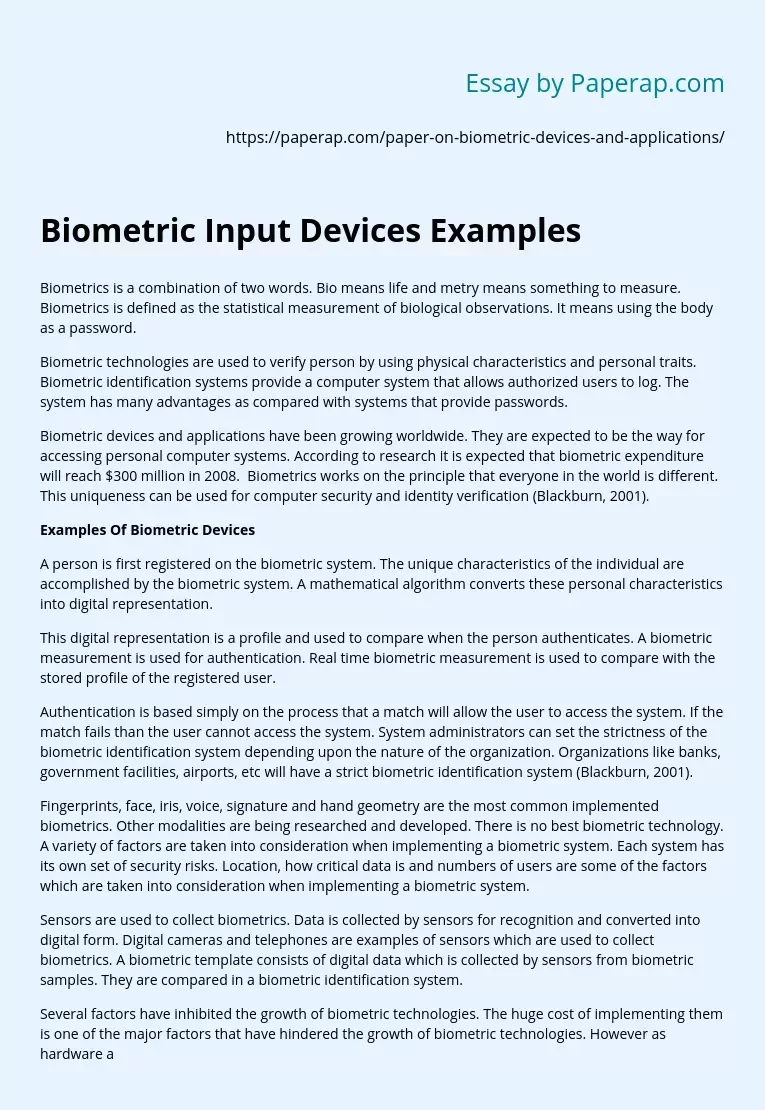Biometric Input Devices Examples
Biometrics is a combination of two words. Bio means life and metry means something to measure. Biometrics is defined as the statistical measurement of biological observations. It means using the body as a password.
Biometric technologies are used to verify person by using physical characteristics and personal traits. Biometric identification systems provide a computer system that allows authorized users to log. The system has many advantages as compared with systems that provide passwords.
Biometric devices and applications have been growing worldwide.
They are expected to be the way for accessing personal computer systems. According to research it is expected that biometric expenditure will reach $300 million in 2008. Biometrics works on the principle that everyone in the world is different. This uniqueness can be used for computer security and identity verification (Blackburn, 2001).
Examples Of Biometric Devices
A person is first registered on the biometric system. The unique characteristics of the individual are accomplished by the biometric system. A mathematical algorithm converts these personal characteristics into digital representation.
This digital representation is a profile and used to compare when the person authenticates. A biometric measurement is used for authentication. Real time biometric measurement is used to compare with the stored profile of the registered user.
Authentication is based simply on the process that a match will allow the user to access the system. If the match fails than the user cannot access the system. System administrators can set the strictness of the biometric identification system depending upon the nature of the organization. Organizations like banks, government facilities, airports, etc will have a strict biometric identification system (Blackburn, 2001).
Fingerprints, face, iris, voice, signature and hand geometry are the most common implemented biometrics. Other modalities are being researched and developed. There is no best biometric technology. A variety of factors are taken into consideration when implementing a biometric system. Each system has its own set of security risks. Location, how critical data is and numbers of users are some of the factors which are taken into consideration when implementing a biometric system.
Sensors are used to collect biometrics. Data is collected by sensors for recognition and converted into digital form. Digital cameras and telephones are examples of sensors which are used to collect biometrics. A biometric template consists of digital data which is collected by sensors from biometric samples. They are compared in a biometric identification system.
Several factors have inhibited the growth of biometric technologies. The huge cost of implementing them is one of the major factors that have hindered the growth of biometric technologies. However as hardware and software prices fall it is believed that the cost of biometric technologies will continue to fall.
Newer biometric identification systems are more accurate and secure than previous systems. The internet has also pushed the growth of biometric identification systems. E-commerce websites have been implanting biometric identification systems to allow secure access and protect their consumers from fraud and theft of confidential information (Blackburn, 2001).
Currently new technologies are being developed in the field of biometrics. Vein pattern identification is one of these technologies which use infrared light to produce a vein’s image. This technology works on veins which are difficult to erase or tamper with. Another technology is ear shape identification which measures ear geometry.
Research is also being conducted on body odor identification. Another development is being undertaken in the design of systems that use body salinity identification. These systems use natural level of salt in the human body to identify people. DNA matching is a potential futuristic technology which could be the ultimate biometric technology. Research is being conducted in palm print identification and electronic nose identification systems (Blackburn, 2001).
Biometrics is an evolving field which is being used in various industries and circumstances. Biometric technologies have been defined as automated methods of recognizing identities by using physiological and behavioral characteristics. Automated methods include mechanisms to scan images of personal characteristics. They can also include compressed images which are stored in databases. Finally these automated methods can also act as interfaces for applications (Blackburn, 2001).
Another important factor in the design of biometric identification systems is the distinction between physiological and behavioral characteristics. Fingerprints, iris patterns and blood vessel patterns are examples of physiological characteristics.
Behavioral traits include typing patterns, unique speaking ability and speech identification. Identification and verification are two different characteristics which are taken into consideration during the design of biometric technologies. Identification includes the process by which the brain performs identifications. Verification is the process to authenticate a person’s identity.
Retinal scans are electronic scans of the eyeball’s wall. They remain stable and have accuracy. The disadvantage of such a system is that it requires close contact and might not be acceptable to the public. Another biometric system in use is iris recognition. It records iris by using video technology. It does not require close physical contact.
However the system is relatively expensive to maintain and requires huge computer storage. Finger imaging is the most popular and common biometric system in use. It records fingerprints using an optical scanner. It is popular in law enforcement agencies. It is also a reliable biometric system. The disadvantages of the system are that it requires close physical contact. It can also cause recognition problems (Bowman, 2005).
Biometric Input Devices Examples. (2019, Dec 05). Retrieved from https://paperap.com/paper-on-biometric-devices-and-applications/

